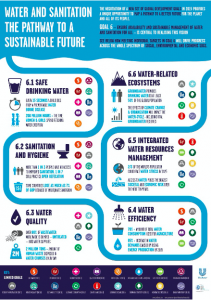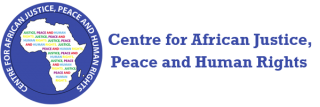By Melissa Philippou
Today, billions of people around the world do not have access to clean water and sanitation services.[i]According to the United Nations (UN), one in three people globally do not have access to safe drinking water, while two out of five people do not have a basic hand-washing facility, and more than 673 million people still practice open defecation.[ii] Setting the UN Sustainable Development Goal (SDG) 6 (see Appendix) has thus been fundamental in ensuring access to water and sanitation for all, regardless of their ethnicity, gender, social class, religion or even geographical location.[iii]
In commemoration of World Water Day on 22 March, it is important to note that the COVID-19 pandemic has highlighted the significance of having access to adequate water, sanitation, and hygiene (WASH) services and facilities. The key findings being that access to WASH is crucial for preventing and containing diseases, and ultimately, for saving lives. Yet, it has also put the spotlight on the profound wider socioeconomic impacts of unequal access to WASH, stressing that the trans-national transmission of the coronavirus pandemic, or any other epidemic or pandemic for that matter, can only be fully realized with equal access to prevention measures and adherence to good hygiene practices. This is particularly true for low-income, low-capacity and at-risk communities as well as people in rural areas, urban slums and disaster-prone regions, as climate change and the lack or limited access to WASH are often intertwined. Therefore, access and availability to these basic human needs are vital to preserving not only the health and well-being of millions of people,[iv] but also forming resilient communities that live in healthy environments.[v]
The accessibility of WASH facilities and climate change are also instinctively tied to children’s right to access education. Indeed, 31% of schools globally lack access to safe water and adequate sanitation.[vi]Nonetheless, growing up in a clean, healthy and safe environment is every child’s right. Access to clean water, basic toilets, and good hygiene practices is a means for children to thrive, giving them a healthier start in life.[vii] Yet, even before the coronavirus pandemic, over 700 children under the age of 5 were dying daily due to diarrheal diseases as a result of the lack of appropriate WASH services[viii]. In areas of conflict, children are nearly 20 times more likely to die from diarrhoeal diseases than from the conflict itself.[ix] These figures thus point to an important conclusion: the lack of clean WASH facilities in schools prevents children from attending school, and subsequently from exercising their human right to access education.
Let’s take a closer look at the impacts of the lack of access to WASH facilities in numerous parts of the world on education, by first examining the ways through which WASH and climate change intersect, and then by outlining and analyzing their consequences on education.
WASH and Climate Change
According to the United Nations World Water Development Report of 2020, climate change directly affects the availability, quantity and quality of water for basic human needs, threatening as a result the effective enjoyment of the human rights to water and sanitation for potentially billions of people.[x] The hydrological changes induced by climate change have already added acute challenges to the sustainable management of water resources, which are already under severe pressure in many regions of the world. Africa for example is one of the most affected continents, having the most water-related disasters – droughts, floods, landslides and storms – from 2001 to 2018.[xi] Sub-Saharan Africa in particular has seen the most severe impacts of climate change on water resources, with numerous studies signaling that rainfall has significantly been reduced in southern Africa, causing additional water stress, especially in urbanized areas.[xii]
It is therefore evident that the most striking effects of climate change can be seen and felt through water. That is for various reasons, primarily, greater demand for water due to low rainfall can cause water sources to run dry, placing even more pressure on the access to water and a greater burden onto those who do not have this access[xiii]. Similarly, heavy rainfall and flooding have the potential to not only damage water sources and sanitation facilities, but at the same time, contaminate the water supply as the waste is carried into streams and lakes[xiv]. Severe droughts can nevertheless have the same effects, forcing people to resort to even less safe sources of drinking water[xv]. In general terms, climate change contributes to the increased unpredictability of weather patterns, accelerating and making more frequent extreme weather conditions and natural disasters.[xvi] In addition, sewage systems are flooded with increasing frequency, contaminating water sources and the local environment. Climate change is therefore further exacerbating the threat of contracting waterborne diseases such as cholera[xvii].
Most importantly however, water scarcity often leads to the inequitable access of water,[xviii] having detrimental effects on vulnerable communities. In fact, it is people in low-income countries that carry the greatest burden of climate change, and it is the poorest communities amongst them that live “on the brink of the climate crisis.”[xix] This is because these communities are the least able to prepare and protect themselves along with their surrounding environments. It is thus evident that “without durable, climate-resilient water and sanitation systems, people struggle to cope.”[xx]
WASH, Climate Change and Education
The less frequent availability of water as well as the unequal access to water facilities also have devastating consequences on children and their learning. First and foremost, households in low-income countries often do not have sufficient opportunities to collect the amount of safe water needed for proper handwashing and hygiene, hence limiting children’s ability to grow up healthy and strong.[xxi]
This is precisely the case for roughly half of primary schools in developing countries too, who do not have access to adequate water facilities and nearly two thirds lacking adequate sanitation.[xxii] UNICEF’s report ‘Raising Clean Hands’ highlights that “unsafe water, inadequate sanitation and lack of hygiene not only affect the health, safety, and quality of life of children” but also “the lives of an estimated 1.5 million children under the age of five who die each year from diarrhea.”[xxiii] Furthermore, children, particularly in developing countries, suffer a disproportionate amount of the WASH-related disease burden, with more than 20% of deaths and years lived with disabilities attributed to inadequate sanitation, insufficient hygiene or drinking unsafe water.[xxiv] Additionally, worms impact an estimated 400 million school children. Indeed, “chronic hookworm infestations are associated with reduced physical growth and impaired intellectual development, and children enduring intense infestations with whipworm miss twice as many school days as their infestation-free peers.”[xxv]
Hence, infectious diseases, being more prominent and easily spread in such environments, can damage children’s physical and mental health, in addition to depriving children of their right to attend school while also limiting their capabilities for achievement. In a study on selected schools in the Harare East District of Zimbabwe, a significant percentage of teachers noted that the lack of availability of water in the schools had serious effects on lesson delivery as well as on the general performance on practical subjects.[xxvi] It was also observed that most of the schools had adopted a policy of ending school days at break time due to water shortages, and pupils were asked to bring water with them or else they would face the risk of being sent back home.[xxvii] Clearly, this indicates the limitations placed on schools and on children by the unequal and inadequate distribution of clean WASH resources in low-income regions.
Further, a lack of private, safe and clean WASH facilities in schools can often deter girls from accessing their right to education. For example, girls and female school staff need access to private, sanitary WASH facilities when menstruating for their own health and safety. In fact, an increasing number of female students drop out of school once they hit puberty due to the lack of privacy.[xxviii] Absenteeism rates among girls who menstruate at schools where no privacy or clean services are provided can reach to 10-20%,[xxix] while female enrollment in schools that had made provisions for safe water and latrines in Kenya saw a “remarkable increase.”[xxx] Moreover, women and girls are particularly vulnerable to sexual harassment in toilets. A survey conducted in South Africa revealed that more than 30% of the girls attending school had been raped while at school, with a significant number of the rapes occurred in school toilets, particularly in the schools where toilets are isolated from its protective environment.[xxxi] In addition, adolescent girls living in areas where there is limited access to water, tend to be in charge for fetching water for the entire household, which an additional burden on them and further limits their ability to attend school.
Conclusion
Undoubtably, the impacts of climate change on water have disproportionately affected children and their right to access education, particularly in low-income countries. As a direct and at times, indirect consequence, children have become way more vulnerable to environmental deficiencies. This is precisely the reason for which more mitigation strategies need to be developed, not only on a national level, but more importantly on a regional and global scale as well, which can prove essential to achieving SDG6 by 2030. Every child, regardless of their geographical location, has the right to access quality education and attend a school that offers safe WASH facilities and services. And by providing safe drinking water, improved sanitation facilities and promoting lifelong health, WASH infrastructures in schools has the capacity to ultimately enhance the wellbeing of children, their families and communities at large, thus paving the way for a new generation of educated and healthy adults.
Appendix

Source: UN (2015) SDG 6 Infographics, Available at: https://www.unwater.org/publications/sdg-6-infographics/ [Accessed 16/3/2021].
[i] Water.org (n.d.) Achieving Sustainable Development Goal 6, Available at: https://water.org/achieving-sdg6/ [Accessed 10/3/2021].
[ii] UN (n.d.) Sustainable Development Goals: Goal 6: Water and Sanitation, Available at: https://www.un.org/sustainabledevelopment/water-and-sanitation/ [Accessed 10/3/2021].
[iii] SDG Tracker (n.d.) Sustainable Development Goal 6, Available at: https://sdg-tracker.org/water-and-sanitation#:~:text=UN%20definition%3A%20By%202030%2C%20improve,recycling%20and%20safe%20reuse%20globally [Accessed 10/3/2021].
[iv] UN (n.d.)
[v] WHO (n.d.) Water, sanitation and hygiene (WASH), Available at: https://www.who.int/health-topics/water-sanitation-and-hygiene-wash [Accessed 10/3/2021].
[vi] Charity Water (n.d.) Clean water means more kids in schools, Available at: https://www.charitywater.org/global-water-crisis/education[Accessed 11/3/2021].
[vii] UNICEF a (n.d.) Water, Sanitation and Hygiene (WASH): Safe water, toilets and good hygiene keep children alive and healthy, Available at: https://www.unicef.org/wash [Accessed 11/3/2021].
[viii] Idem.
[ix] Idem.
[x] UNESCO World Water Assessment Programme (2020) United Nations World Water Development Report of 2020, Available at: https://unesdoc.unesco.org/ark:/48223/pf0000372882 [Accessed 15/3/2021].
[xi] UNESCO (2020)
[xii] Idem, pp. 13
[xiii] UNICEF b (n.d.) Water, sanitation and hygiene (WASH) and climate change, Available at: https://www.unicef.org/wash/climate[Accessed 11/3/2021].
[xiv] Idem.
[xv] Water Aid (n.d.) Climate Chance, Available at: https://washmatters.wateraid.org/climate-change [Accessed 11/3/2021].
[xvi] Idem.
[xvii] Idem.
[xviii] UNICEF b (n.d.)
[xix] Water Aid (n.d.)
[xx] Idem.
[xxi] UNICEF b (n.d.)
[xxii] UNICEF (2010a) Lack of safe water and sanitation in schools affects children’s learning and their lives, Available at: https://www.unicef.org/media/media_53234.html [Accessed 14/3/2021].
[xxiii] UNICEF (2010b) Raising Clean Hands, Available at: https://www.unicef.org/media/files/raisingcleanhands_2010.pdf [Accessed 14/3/2021].
[xxiv] Idem, pp. 4
[xxv] Idem, pp. 8
[xxvi] Chikoore, M.R. and Bowora, J. (2011) The Impact of Water Shortages on Educational Delivery in Selected Schools in Harare East District, Zimbabwe Journal of Educational Research, vol.23 n.3, Available at: https://www.ajol.info/index.php/zjer/article/view/86736[Accessed 14/3/2021].
[xxvii] Idem.
[xxviii] Students Rebuild (2014) The Impact of the Water Crisis on Education, Available at: https://www.studentsrebuild.org/stories/the-impact-of-the-water-crisis-on-education [Accessed 14/3/2021].
[xxix] UNICEF (2010b), pp. 10
[xxx] Lifewater (2014) Water and Education: How Safe Water Access Helps Schoolchildren, Available at: https://lifewater.org/blog/water-education/ [Accessed 14/3/2021].
[xxxi] UNICEF (2010b), pp.11
